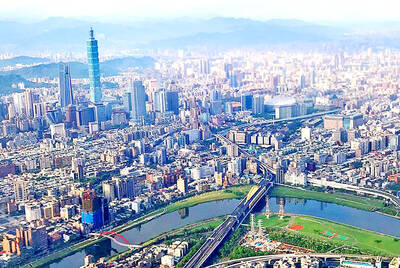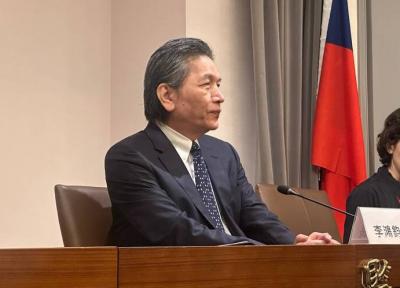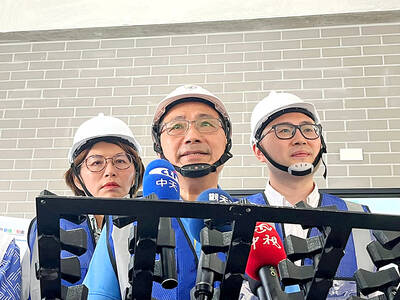Anti-nuclear supporters yesterday called for an amendment to the Nuclear Reactor Facilities Control Act (核子反應器設施管制法) to allow local referendums for residents to decide whether nuclear plants should be built within 50km of their homes.
The amendment was suggested by former vice president Annette Lu (呂秀蓮) at a public hearing to discuss evacuation zones for nuclear reactors hosted by Democratic Progressive Party (DPP) Legislator You Meinu (尤美女) at the Legislative Yuan yesterday.
Lu said that according to Article 11 of the Act on Sites for the Establishment of Low-Level Radioactive Waste Final Disposal Facilities (低放射性廢棄物最終處置設施場址設置條例), sites for building nuclear waste final depositories must be approved by local residents through referendums.
And while nuclear power plants, with fuel rods in the reactors and highly radioactive nuclear waste stored in the spent-fuel pools, pose greater risks to nearby residents than low-level nuclear waste, the law should be amended so that people living within 50km of plant sites can decide on the construction, installation of fuel rods and operation of reactors through local referendums, she said.
DPP Legislator Chen Ou-po (陳歐珀) said the issue of nuclear power safety includes three aspects — the reactors, disaster response measures and waste treatment.
If the problems concerning the latter two aspects could be solved properly, Chen said he could accept a new, safe reactor, but added that “the central government, however, is only fooling the people” because it has no solutions to these problems.
People living in evacuation zones will not allow the central government to sacrifice their rights to safety by arbitrarily allowing nuclear reactors to operate, he added.
Yenliao Anti-Nuclear Self-Help Association secretary-general Yang Mu-huo (楊木火) said he is worried that the northeastern monsoon wind will blow airborne substances from the plant to Shuangsi District (雙溪) in New Taipei City, where the catchment area of the Peishih River (北勢溪) — the water source of the Feitsui Reservoir (翡翠水庫) — is located.
“Spent nuclear fuel is like ‘shit’ from the reactors, and it is ridiculous that proposals for building reactors can gain approval, because it’s like building a house with no toilet to ‘deal with the shit,’” association member Yang Kuei-yin (楊貴英) said.
After complaining that residents were led to sites by the sea in previous nuclear disaster drills, which would be deadly if a complex disaster were to occur, like that in Fukushima, Japan, which included a major tsunami, she suggested that drills without warnings be held to see if the government is as well-prepared as it claims.
Meanwhile, in response to a question from DPP Legislator Tien Chiu-chin (田秋堇) on the scope of evacuation zones for nuclear disaster drills, Taiwan Power Co vice president Chen Pu-tsan (陳布燦) said that one type of drill is limited to only the plant area, and the other type only includes an area between 5km and 8km around the plants, as the law in Taiwan stipulates a distance of 8km as the evacuation zone.
Unsatisfied with the reply, Tien, citing the Japanese government’s evacuation of residents who lived within 20km of the Fukushima Dai-ichi nuclear power plant, said Taiwan should also come up with feasible evacuation plans of at least the same scope.

Taipei has once again made it to the top 100 in Oxford Economics’ Global Cities Index 2025 report, moving up five places from last year to 60. The annual index, which was published last month, evaluated 1,000 of the most populated metropolises based on five indices — economics, human capital, quality of life, environment and governance. New York maintained its top spot this year, placing first in the economics index thanks to the strength of its vibrant financial industry and economic stability. Taipei ranked 263rd in economics, 44th in human capital, 15th in quality of life, 284th for environment and 75th in governance,

The Sports Administration yesterday demanded an apology from the national table tennis association for barring 17-year-old Yeh Yi-tian (葉伊恬) from competing in the upcoming World Table Tennis (WTT) United States Smash tournament in Las Vegas this July. The sports agency said in a statement that the Chinese Taipei Table Tennis Association (CTTTA) must explain to the public why it withdrew Yeh from the WTT tournament in Las Vegas. The sports agency said it contacted the association to express its disapproval of the decision-making process after receiving a complaint from Yeh’s coach, Chuang

Control Yuan Secretary-General Lee Chun-yi (李俊俋) tendered his resignation last night, admitting that he had misused a government vehicle, as reported by media. His resignation was immediately accepted by the Control Yuan. In a statement explaining why he had resigned, Lee apologized for using a Control Yuan vehicle to transport his dog to a pet grooming salon on May 20. The issue first came to light late last month, when TVBS News reported that Lee had instructed his driver to take the dog to the salon. The news channel broadcast photos that it said were taken by an unnamed whistle-blower, which purportedly showed the

The New Taipei City Government would assist relatives of those killed or injured in last month’s car-ramming incident in Sansia District (三峽) to secure compensation, Mayor Hou You-yi (侯友宜) said yesterday, two days after the driver died in a hospital. “The city government will do its best to help the relatives of the car crash incident seek compensation,” Hou said. The mayor also said that the city’s Legal Affairs, Education and Social Welfare departments have established a joint mechanism to “provide coordinated assistance” to victims and their families. Three people were killed and 12 injured when a car plowed into schoolchildren and their